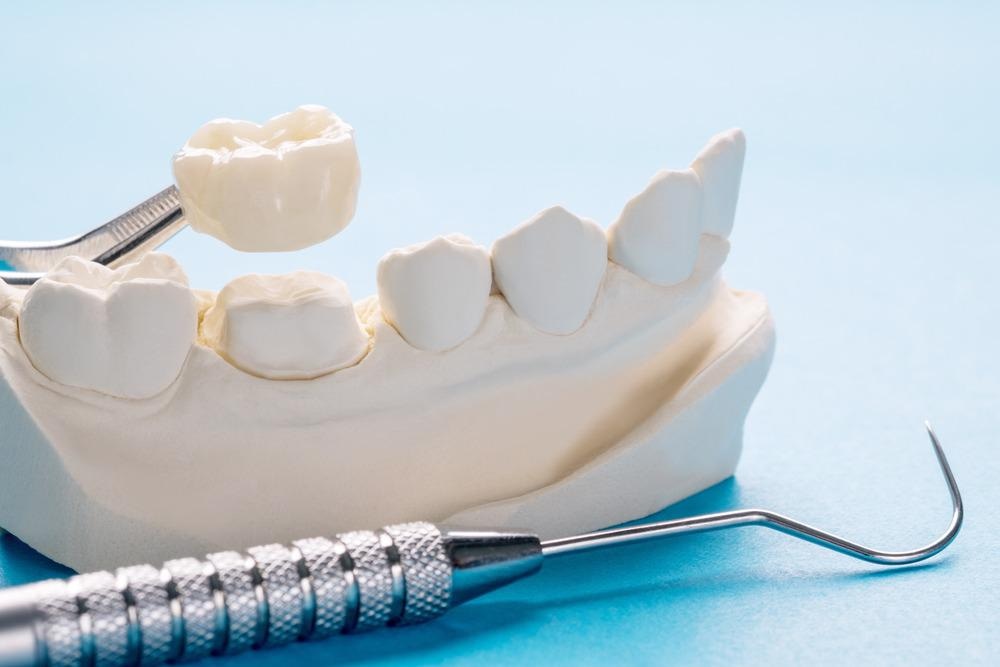Crowns, fixed partial dentures, and post-and-core are viable applications of fixed dental prostheses that use polyetheretherketone (PEEK). Owing to its superior mechanical qualities, it distributes stress more evenly than traditional materials, safeguarding the abutment teeth. Novel research published in Polymers looks at its applications in dentistry and methods such as laser treatment for increasing the adhesive characteristics of PEEK.

Study: PEEK in Fixed Dental Prostheses: Application and Adhesion Improvement. Image Credit: sujit kantakat/Shutterstock.com
What is Polyetheretherketone (PEEK)?
PEEK, a polyaryletherketone (PAEK) family member, has lately gained traction as a plausible alternative polymer for permanent dental prosthesis. PEEK is a high-impact polymer with excellent chemical resistance.
It has superior tensile characteristics, including a low Young's modulus (3 to 4 GPa), which is comparable to that of human cortical bone (14 GPa) when contrasted to metallic alloys, making it a favored choice for biomedical engineering.
What Advantages does PEEK offer?
PEEK offers several upsides, including the ability to withstand high-temperature thermal pressures (melting point, 343 °C) without serious deterioration, low water solubility (0.5%), and the ability to minimize biocorrosion within biological fluids, preventing the discharge of metallic ions that can cause cell toxicity, autoimmune disease, and infection.
PEEK not only extends the life of a denture but also preserves the anchoring teeth as well as other tissues around it.
It can provide significantly better stress transfer phenomena in dental sciences, decreasing strain absorption when used as a prosthesis and minimizing the danger of root laceration when used as a post-and-core restorative. There is presently no proof that PEEK causes adverse immunological reactions, therefore it can be used as a substitute material for persons who are allergic to metals.
Overcoming Polyetheretherketone Limitations
The elasticity of PEEK (shear strength 110 MPa) is insufficient to maintain the load-bearing pressure as opposed to traditional polymers. PEEK can be integrated with glass fibers or carbon fibers to improve mechanical characteristics and resolve this limitation.
Glass fiber reinforced-PEEK and carbon fiber reinforced-PEEK, in particular, have Young's modulus (12 GPa and 18 GPa) that are even closer to that of bone fragment and dentin, as well as better tensile stiffness (170 MPa) and excellent color consistency, resulting in more favorable results.
A Comparison of PEEK and Zirconia
Another excellent substance for implant placement is zirconia. It is biologically inert meaning it will not cause biochemical processes, spread to other areas of the body, or deteriorate. This serves as the core reason for it being the non-metal titanium substitute. Its naturally white appearance makes it the ideal material for restorative dentistry.
PEEK is a gray-colored metal-free polymer. When contrasted to metals and their alloys, it improves the aesthetics of implant dentistry, but when contrasted to zirconia, it lacks a suitable aesthetic result when used for permanent dental applications.
Uses of PEEK in Dental Crowns
Regular mastication and increasing weathering cause the crowns to wear out, so they must be made from materials that are resistant to wear. PEEK has higher tensile strength (140 to 170 MPa) than traditional materials when it comes to fracture toughness. In circumstances where other supplementary therapies are anticipated, PEEK is advised as a long-term interim crown substance.
In vitro, PEEK has the minimum peripheral and structural separation measurements, as well as the highest fracture toughness, when compared to polylactic acid and PMMA. PEEK-coping crowns have superior marginal compliance and intrinsic adaptability than zirconia-coping crowns, and both are clinically acceptable.
Is PEEK Preferred in Fixed Partial Dentures (FDPs)?
PEEK could be synthesized within a lesser timeframe and is more lightweight than zirconia in terms of medical applicability for FPDs. When the updated Ryge Criteria and the California dental assessment system were used to evaluate its performance, it produced acceptable clinical efficacy. During the assessment, merely 5% of PEEK FPDs collapsed due to de-bonding, with the remainder of restorations staying fracture-free.
PEEK has been investigated in vitro for practical utilization in Endo crowns and inlays, in addition to typical permanent implants. In comparison with its competitors, PEEK Endo-crowns had the minimum retaining force due to de-cementation.
Strategies for Improvement of PEEK Properties
Acid etching can improve PEEK's shear bond strength (SBS). It was discovered that etching PEEK with 98 percent sulfuric acid resulted in a highly permeable substrate surface, which improved adherence.
Plasma treatment has shown significant potential as a profound method to modify the exterior of PEEK. The surface morphology and water sorption of PEEK can be increased by sandblasting. Similarly, laser therapy for enhancing PEEK adhering has been the focus of many studies.
In the future, more work should be put into figuring out the ideal blend of surface functionalization and pre-treatment approaches for increasing PEEK adhesive abilities and dental performance.
Disclaimer: The views expressed here are those of the author expressed in their private capacity and do not necessarily represent the views of AZoM.com Limited T/A AZoNetwork the owner and operator of this website. This disclaimer forms part of the Terms and conditions of use of this website.
Source:
Wang B. et. al. (2022). PEEK in Fixed Dental Prostheses: Application and Adhesion Improvement. Polymers. 14(12). 2323. Available at: https://www.mdpi.com/2073-4360/14/12/2323